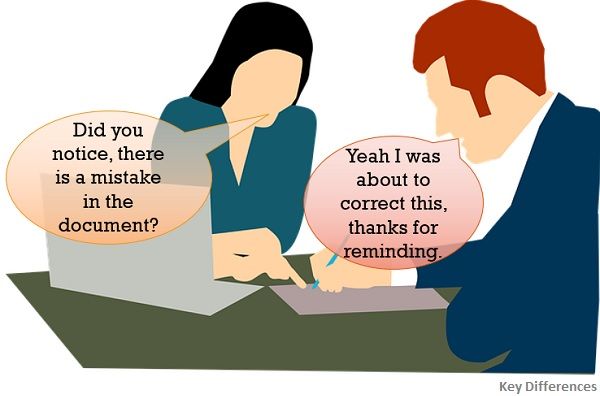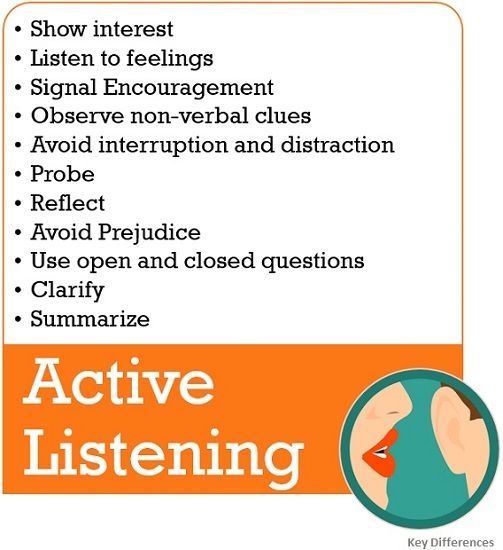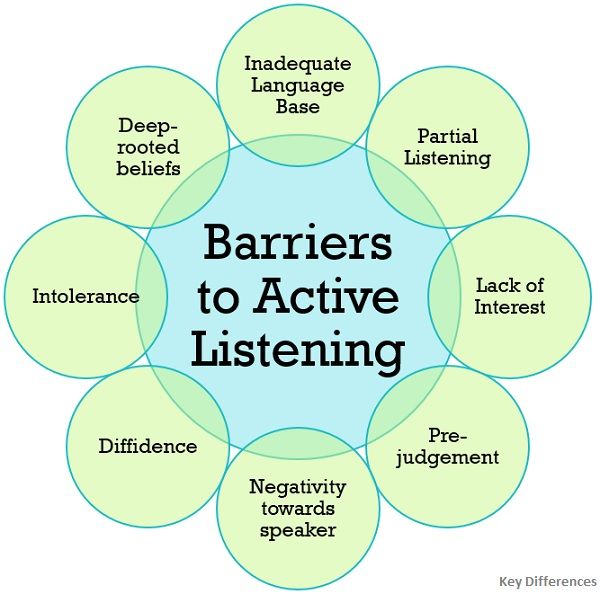 In active listening, the listener carefully pays attention to the words of the speaker and responds accordingly. On the other hand, in the case of passive listening, the listener only hears the speaker’s statement but does not respond to it.
In active listening, the listener carefully pays attention to the words of the speaker and responds accordingly. On the other hand, in the case of passive listening, the listener only hears the speaker’s statement but does not respond to it.
An active listener is one that pays complete attention to the physical details of the speaker, for example, appearance, body language, expressions, etc. which play a crucial role in translating the meaning of the spoken matter. Oppositely, a passive listener neglects the physical aspects of the speaker, as he/she is not really interested in what is being said.
What is Listening?
Do you guys know that on an average 45-75% waking hours of an individual are spent in listening and not in talking? Listening is an activity which involves receiving, interpreting and responding to the message spoken by the speaker.
Effective listening is an important part of effective communication, which determines the person’s ability to understand the message. It can be active listening or passive listening,
This writeup will help you understand the difference between active listening and passive listening.
Content: Active Listening Vs Passive Listening
Comparison Chart
| Basis for Comparison | Active Listening | Passive Listening |
|---|---|---|
| Meaning | Active Listening is a process of transforming the thought or statement into a clear message, with full-fledged involvement from the listener's side. | Passive Listening is a process of simply consuming the message, however, there is no involvement from the listener's side. |
| Process | Interactive | Mechanical |
| Role of Listener | Listener stimulates the speaker to speak up his ideas willingly, by displaying his/her interest, in the conversation. | Listener dispirits the speaker by showing boredom and disinterest, on his face. |
| Involves | Reacting while listening | Listening without reacting |
| Communication | Two-way Communication | One-way Communication |
| Feedback and Question | Present | Not present |
| Listener | Concentrates understands, responds and remembers the statement spoken by the speaker. | Thinks about other topics, while showing that he/she is listening. |
| Non-verbal clues shown by the listener | Change in facial expression, Rolling of eyes, showing interest by questioning or smiling, etc. | Yawning, looking here and there, showing boredom, being silent etc. |
Definition of Active Listening
Active listening as the name suggests is the process wherein the listener, carefully hears what the speaker says, processes the message and then responds to the message so as to lead the conversation further.
Active Listening involves paying full attention to the speaker, showing interest in what he/she is saying through expressions, body language and asking questions at timely intervals, to make a good conversation.
He/she consciously makes effort to:
- Concentrate on what is being said
- Decode the message
- Participate in conversation
- Helps the speaker to deliver the message meaningfully.
Both verbal and non-verbal clues play an important role in active listening, wherein verbal clues involve repeating the lines or summarizing the matter spoken, providing suggestions or disagreeing with the thoughts and asking suitable questions, whereas non-verbal clues include nodding, eye contact, etc.
For Example: Active listening can be found in a press conference, debate, etc
Who are Active Listeners?
Active Listeners are those individuals who are actively involved in the process of communication, not just by attentively listening to the message but also by carefully noticing the manner in which the message is delivered. In other words, active listeners pay attention to the content and manner, i.e. the tone, pitch, body language, facial expressions, etc. of the speaker, when the message was delivered.
Active Listeners often seek clarifications, nod their head at timely intervals, ask leading questions and also summarize the content to exhibit that they followed the speaker.
Also Read: Difference Between Hearing and Listening
Definition of Passive Listening
Passive Listening means listening to the speaker during the communication but in an unconscious manner. He/She sits quietly without responding to the speaker. It is silent and patient listening, wherein the listener neither interrupts nor participates in the conversation.
This means that the listener is present physically, but may not be paying attention to the speaker’s speech due to which the message is not absorbed by the listeners as well as he/she may not be able to recall it in future.
The causes of passive listening are:
- Tiredness
- Multitasking
- Disinterest
- Ill health
Simply put, in passive listening, the listener is just listening to the words but not the message. This often leads to a misunderstanding between the speaker and listener, as the speaker would think that the listener has got the message accurately.
For example: Passive listening is seen during Seminar attended by the students
Who are Passive Listeners?
Passive Listeners are the ones who listen to the message partially. Moreover, there is also the absence of sensitivity to nuances, hidden meanings, nonverbal clues which are involved in the communication.
Basically, what a passive listener do is they let the other person speak without any interruption or clarification. Hence, communication with a passive listener is ineffective and incomplete.
Key Differences Between Active Listening and Passive Listening
The points stated below discuss the difference between active listening and passive listening:
- Active listening is when the listener in the communication absorbs all that is being spoken by the speaker, as well as makes effort to verifies the facts by asking questions. On the other hand, passive listening is when the listener is physically present during the presentation but mentally absent, wherein all that is spoken by the speaker is heard by the listener but not absorbed.
- While active listening is an interactive process, passive listening is a mechanical process.
- In active listening, the listener encourages the speaker to speak up further, by showing interest in the conversation. As against, a passive listener often discourages the speaker by not focusing on the listening process and showing boredom and disinterest on his face.
- Active listening is supported by nodding, eye contact, asking questions, if necessary, etc. On the contrary, passive listening is denoted by ungainly posture or looking here and there, etc.
- Reaction or response plays a very important role in listening, it shows how attentive or keen the listener is. In passive listening there is listening without reacting, however, it is not same as hearing. In this the listener allows the speaker to speak without any interruption, as well as not pays attention to the speaker’s speech. Conversely, active listening is characterized by response or reaction on the part of the listener.
- Passive Listening is a one-way communication, as the listener or receiver does not provide his/her feedback to the speaker. On the other hand, active listening is a two-way communication which includes appropriate responses, which indicates that the listener is not just hearing but also understanding, what the speaker is saying.
- An active listener shows his keenness for information by asking more questions, offering suggestions, agreeing or disagreeing with the thoughts of the speaker, whereas a passive listener always wants the speaker to wrap up the topic as soon as possible, so he/she does not lead the topic further by asking questions or offering suggestions.
- In active listening, the listener concentrates, understands, responds and remembers the statement spoken by the speaker. In contrast, in passive listening, the listener is usually engrossed in his/her own thoughts and does not pays attention to the speaker but only pretends that he/she is listening.
- Non-verbal clues shown by an active listener are – change in facial expression, rolling of eyes, showing interest by questioning or smiling, etc. On the other hand, passive listener generally exhibits non-verbal clues such as yawning, looking here and there, showing boredom, being silent etc.
Barriers to Active Listening
The barriers to active listening are represented below:
Now, let us discuss them one by one:
| Inadequate Language Base | Active listening requires good language base so as to understand the speaker clearly. Even if the listener attempts to participate in the process of communication, if the language base is poor, it will act as a deterrent in actuve listening. For example: Suppose a teacher gives lecture in English, but the student is not fluent in English, so here inadequacy of language will act as a barrier. |
| Partial Listening | Partial listening is when people are involved in multiple tasks at the same time, which distracts them easily. For example: Suppose two people are talking on call, while one person is saying, the other person is flipping the pages of a file or drinking water, so there is lack of attention. Hence, as multitasking is done by the person, important points of the conversations tend to be missed out. |
| Lack of interest | Lack of interest in the topic of discussion is one of the major factor which acts as a barrier to the active listening process. For example: If one person is saying something to another person about politics, and the receiver is not at all interested in it, so there are chances that he will not pay his attention to what the speaker is saying. |
| Pre-judgement | There are instances when a listener pre-judges or forms his/her opinion about the speaker on the basis of his appearance, attire, accent, status, and mannerism. However, these biases differs person by person. |
| Negativity towards the Speaker | Listener's metal, emotional and psychological perspective towards the speaker, also plays a major role in active listening. This is because, if a person does not like the speaker or disapprove his ideas, then the chances of distortion or misinterpretation of the message is quite high. For example: Suppose the speaker and listener believe in different ideologies, so the listeners usually exhibits animosity, and also continues to disagree with the speaker's views. |
| Diffidence | Lack of confidence results in diffidence. That is why many listeners tend to understand their potential and decide beforehand that they won't be able to understand what the other person is going to speak. This often affects the process of communication. |
| Intolerance | Some listeners are intolerant in nature, which may be because he/she is over enthusiastic or impatient. And that is why he/she feels that speaker is slow in communication. Hence, before the speaker could finish speaking, the listener advances questions and also interuppts while he/she is speaking. And so the listener generally assumes everything in advance, which prevents him/her from active listening. |
| Deep-rooted beliefs | Some people are narrow minded, due to their so-called beliefs, judgement and stereotypes. These beliefs are so strong that it works as a barrier to new ideas and thoughts. |
Examples
Given below are some common examples of active listening and passive listening:
| Active Listening | Passive Listening |
|---|---|
| Group Discussion | Watching TV while eating food. |
| Students asking questions from the teacher on the topic explained. | Listening to someone while operating mobile. |
| Job Interview | Listening to the speaker during the presentation. |
Conclusion
In a nutshell, listening is an attentive process, which requires a person to consciously think to listen properly. The degree of attentiveness has a crucial role to play in the process of listening. The difference between active and passive listening lies in the listener’s attention and involvement in the conversation.






Adil Nazir says
Nice post
Adil Nazir says
Super
abduli mshule says
these differences are very good as you have said that they lie on the listeners attention in your conclusion
Nyankiir Aguek says
The difference are very good and clear
Merilyn J Duckworth says
This article had me an active listener, a lot of differences and like they say “You really brought it home. Now I have full knowledge of the differences including examples.
Merilyn Duckworth
5/13/2022
hossein says
The differences are very good and clear
Amari Superville says
This article is the formal teaching of the skill of listening.
Marcio Teixeira says
Wow, so much valuable content; thanks so much for sharing
Joyce Tampin says
Very good